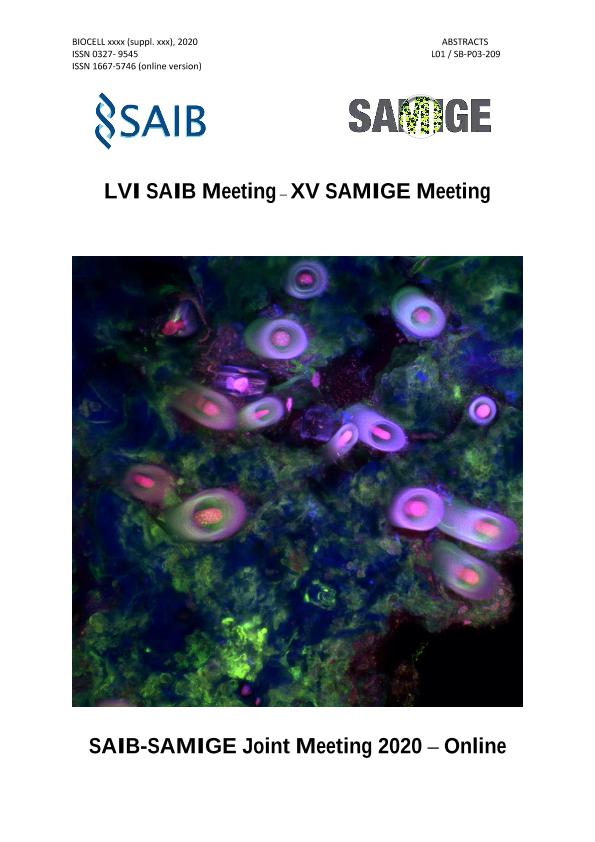Mostrar el registro sencillo del ítem
dc.contributor.author
Gitman, Iván Federico Berco

dc.contributor.author
Grossi, Cecilia Eugenia María

dc.contributor.author
Ulloa, Rita Maria

dc.date.available
2023-07-03T14:03:46Z
dc.date.issued
2020
dc.identifier.citation
Comparative genomics of the PGPR isolate Methylobacterium sp. 2A; LVI Annual Meeting Argentine Society for Biochemistry and Molecular Biology; XV Annual Meeting Argentinean Society for General Microbiology; CABA; Argentina; 2020; 1-1
dc.identifier.issn
0327-9545
dc.identifier.uri
http://hdl.handle.net/11336/202019
dc.description.abstract
Methylobacterium sp. 2A is a plant growth-promoting rhizobacteria (PGPR) that was isolated from roots of potato plants and enhanced growth in potato and Arabidopsis plants under high salt conditions. Whole genome sequencing revealed metabolic pathways associated with its plant growth promoter capacity. A comparative genomic analysis was performed through the pangenomic approach between Methylobacterium sp. 2A and four closest relatives of the genus: M. phyllostachyos BL47, M. organophilum DSM 760, M. radiotolerans JCM 2831, and M. pseudosasicola BL36. A core-genome of 3,584 genes was identified, while 724 genes were exclusive of this isolate. The genomic island (GI) prediction of Methylobacterium sp. 2A and related species was performed by IslandViewer using integrated methods. Although weak, a correlation between GC content and percentage of exclusive genes in GIs was inferred in all species. In the Methylobacterium sp. 2A assembly, 26 genomic islands were predicted with a total of 473 protein-coding genes, representing 8.6 % of the entire genome. The prediction showed that the largest GI has a length of 68.6 Kbp and the smallest 4.3 kbp. Also, a comparison of these organisms was carried out by the functional annotation of COGs and the assignment of them to one of the 26 functional categories. COG analysis showed that COG0784 and COG0840 containing CheY chemotaxis proteins and methyl-accepting chemotaxis proteins (MCPs) are the most abundant ones in the analyzed pangenome. MCPs are chemoreceptors that sense a vast set of environmental signals enabling soil bacteria to establish plant-microbe interactions. Both, MCPs and CheY are involved in signal transduction mechanisms that modulate cell motility. The MCP signaling domain is highly conserved because it maintains multiple protein-protein interactions within the chemoreceptor-kinase complex, while MCP sensory domains are quite variable in sequence. Preliminary phylogenetic analysis of the 55 Methylobacterium sp. 2A MCPs suggests that these proteins are grouped in at least four big clusters. ScanProsite analysis revealed the presence of one or two transducing domains, HAMP, PAS and/or PAC domains in the different analyzed protein sequences. The comparative genomic analysis presented in this work revealed the relationship between Methylobacterium sp. 2A with related members of the genus, providing valuable information on its genetic and evolutionary diversity.
dc.format
application/pdf
dc.language.iso
eng
dc.publisher
Tech Science Press

dc.rights
info:eu-repo/semantics/openAccess
dc.rights.uri
https://creativecommons.org/licenses/by-nc-sa/2.5/ar/
dc.subject
Methylobacterium sp. 2A
dc.subject
Genomics
dc.subject.classification
Biología Celular, Microbiología

dc.subject.classification
Ciencias Biológicas

dc.subject.classification
CIENCIAS NATURALES Y EXACTAS

dc.title
Comparative genomics of the PGPR isolate Methylobacterium sp. 2A
dc.type
info:eu-repo/semantics/publishedVersion
dc.type
info:eu-repo/semantics/conferenceObject
dc.type
info:ar-repo/semantics/documento de conferencia
dc.date.updated
2022-11-01T23:04:56Z
dc.identifier.eissn
1667-5746
dc.journal.volume
XXX
dc.journal.number
Suppl. XXX
dc.journal.pagination
1-1
dc.journal.pais
Estados Unidos

dc.journal.ciudad
Henderson
dc.description.fil
Fil: Gitman, Iván Federico Berco. Consejo Nacional de Investigaciones Científicas y Técnicas. Instituto de Investigaciones en Ingeniería Genética y Biología Molecular "Dr. Héctor N. Torres"; Argentina
dc.description.fil
Fil: Grossi, Cecilia Eugenia María. Consejo Nacional de Investigaciones Científicas y Técnicas. Instituto de Investigaciones en Ingeniería Genética y Biología Molecular "Dr. Héctor N. Torres"; Argentina
dc.description.fil
Fil: Ulloa, Rita Maria. Universidad de Buenos Aires. Facultad de Ciencias Exactas y Naturales. Departamento de Química Biológica; Argentina. Consejo Nacional de Investigaciones Científicas y Técnicas. Instituto de Investigaciones en Ingeniería Genética y Biología Molecular "Dr. Héctor N. Torres"; Argentina
dc.relation.alternativeid
info:eu-repo/semantics/altIdentifier/url/https://saib.org.ar/archivos/biocell-45.pdf
dc.relation.alternativeid
info:eu-repo/semantics/altIdentifier/url/https://samige.org.ar//wp-content/uploads/2022/10/Libro-de-resumenes-2020-Biocell.pdf
dc.conicet.rol
Autor

dc.conicet.rol
Autor

dc.conicet.rol
Autor

dc.coverage
Nacional
dc.type.subtype
Reunión
dc.description.nombreEvento
LVI Annual Meeting Argentine Society for Biochemistry and Molecular Biology; XV Annual Meeting Argentinean Society for General Microbiology
dc.date.evento
2020-11-02
dc.description.ciudadEvento
CABA
dc.description.paisEvento
Argentina

dc.type.publicacion
Journal
dc.description.institucionOrganizadora
Sociedad Argentina de Investigación en Bioquímica y biología Molecular
dc.description.institucionOrganizadora
Sociedad Argentina de Microbiología General
dc.source.revista
Biocell

dc.date.eventoHasta
2020-11-05
dc.type
Reunión
Archivos asociados
